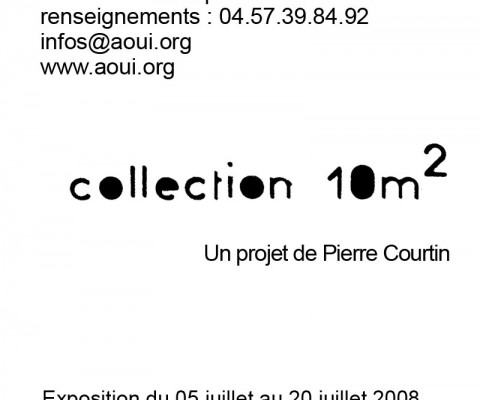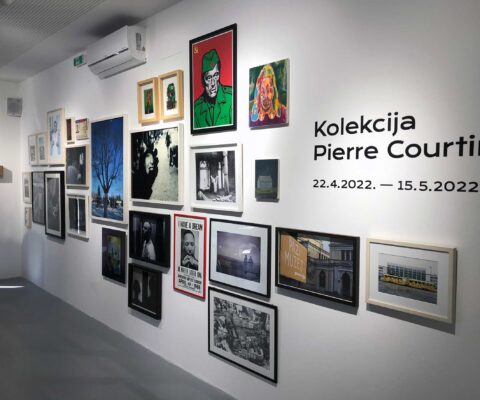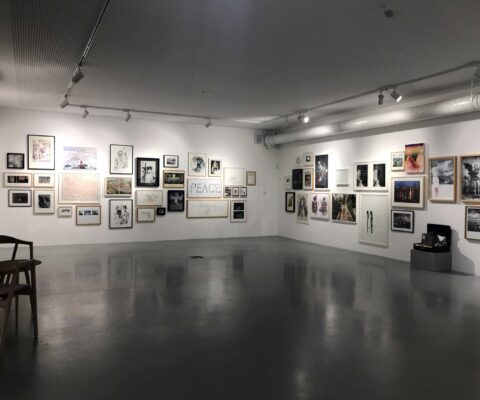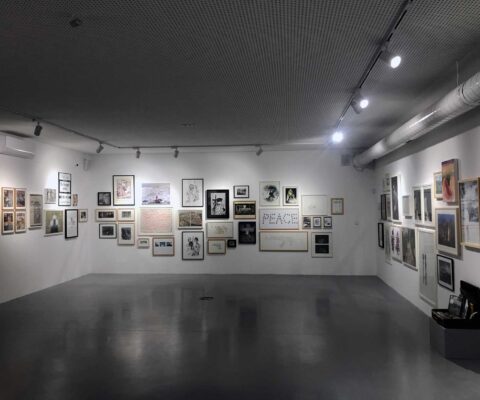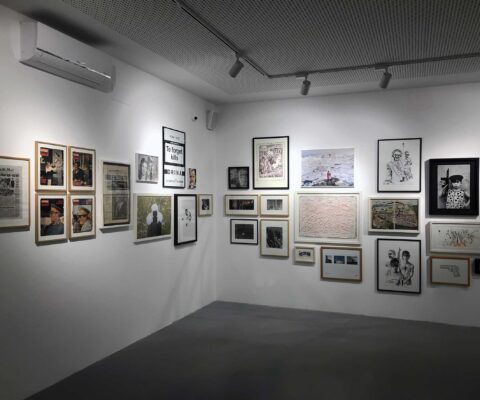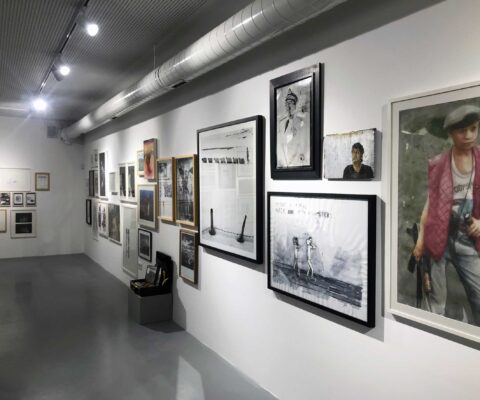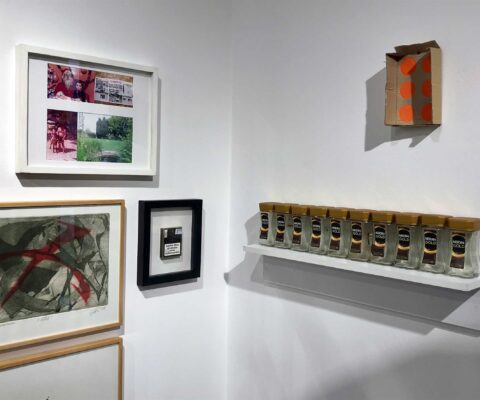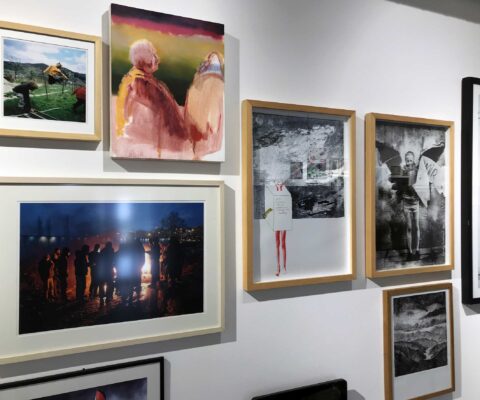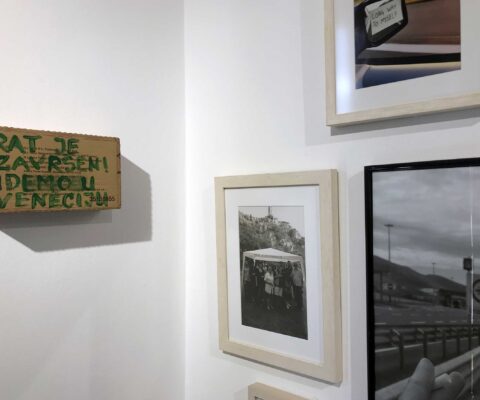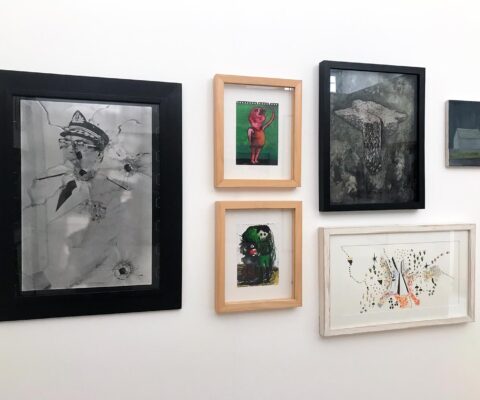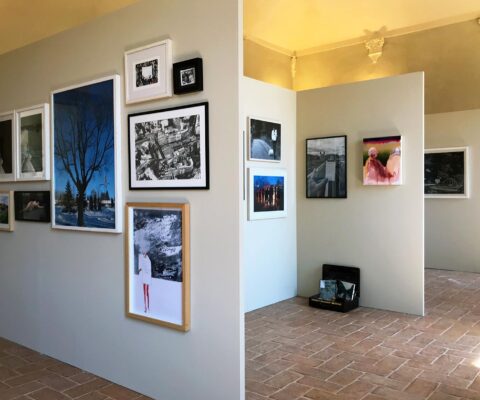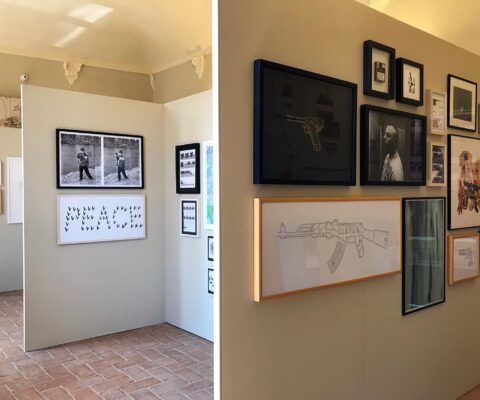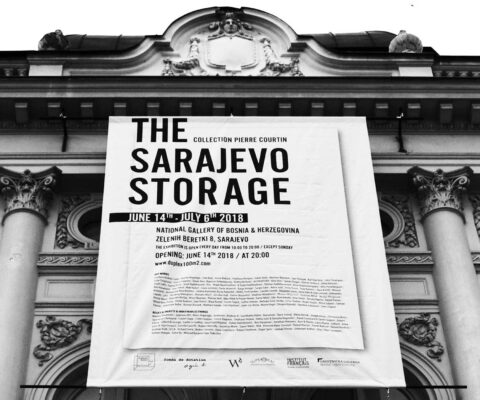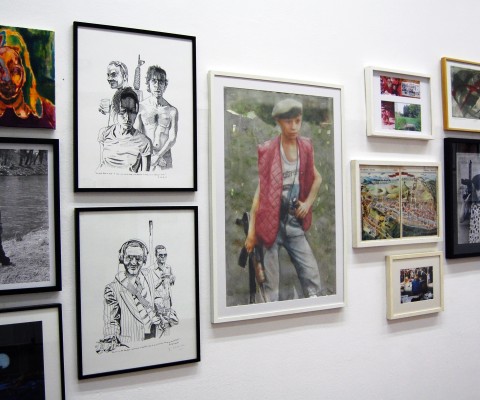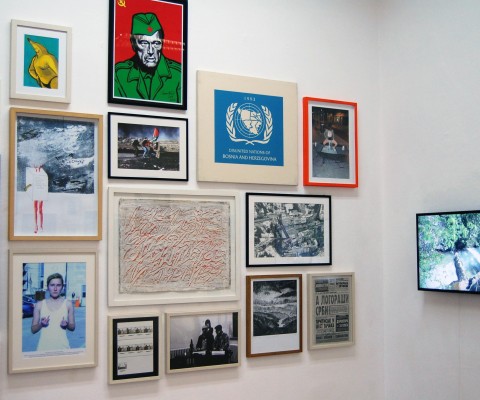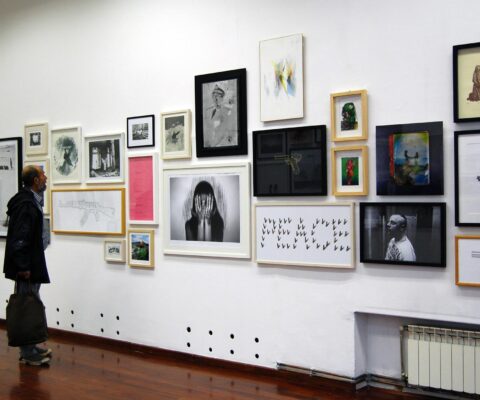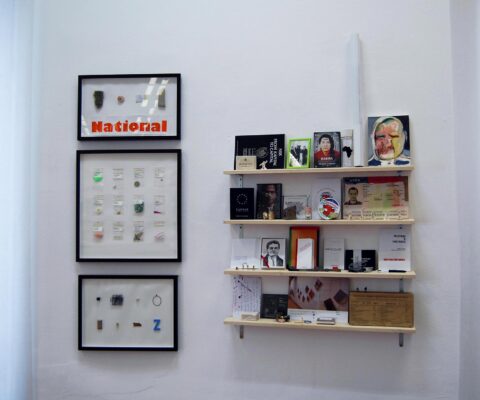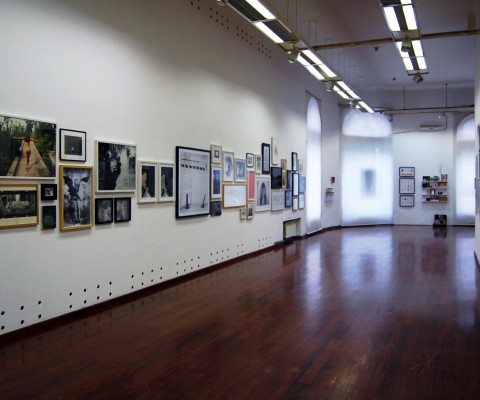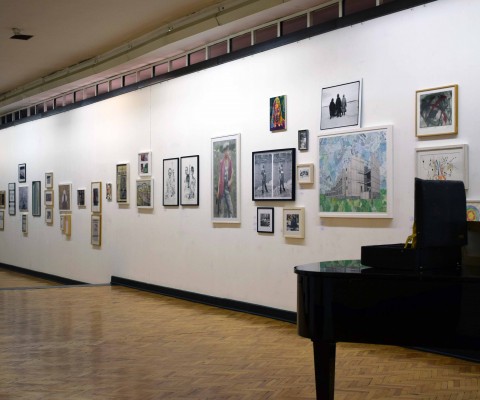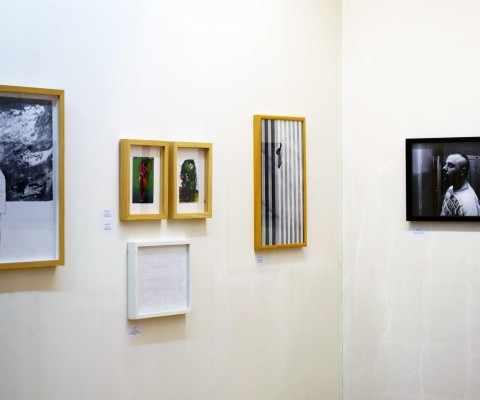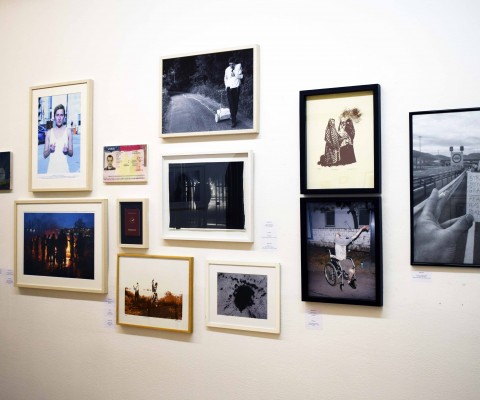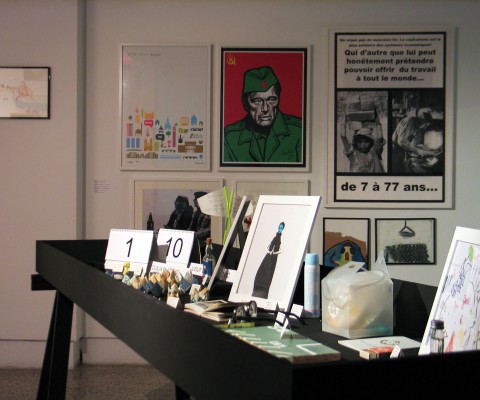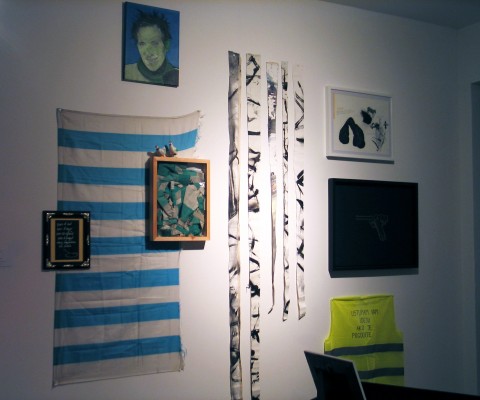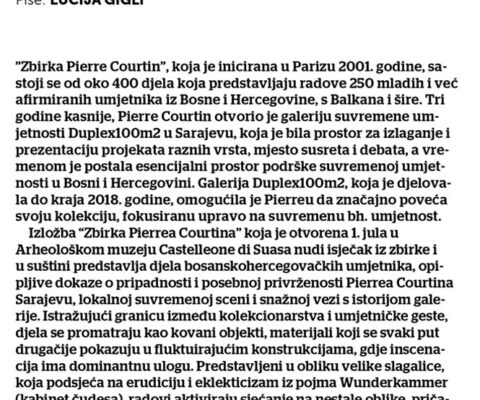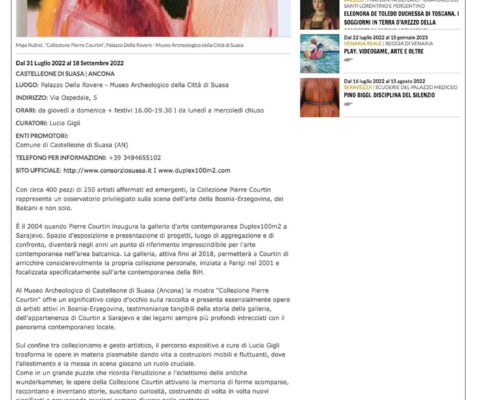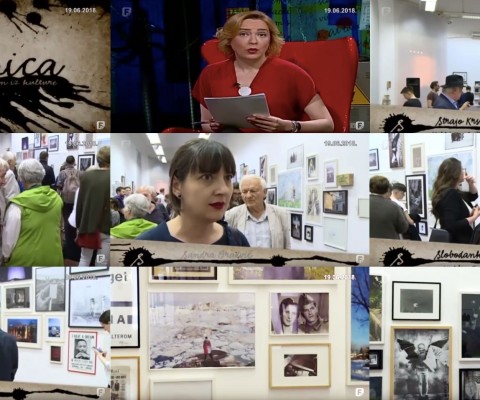Collection Pierre Courtin – 2001/2022
Started in 2001, the collection of Pierre Courtin consists today of 400 pieces. Exploring the borders between collection’s work, artistic gestures, and exhibiting art works in galleries, it displays only the part of its own ambivalence: true-false collection where the « complete » works are mixed with fragment works, which are just as many other exhibition souvenirs, relics, cult objects, which seem to ironically, send us to the vanity of entire collection’s act, its desire to be written in history, a « supra humane » temporality.
Extracts from the collection have been presented at the Art Center OUI in Grenoble in 2008 (FR), at the Art Center Duplex10m2 in Sarajevo in 2012 (BiH), at the Art Center BANG in Chicoutimi in 2013 (CA), at the National Gallery of Bosnia and Herzegovina in Sarajevo and at the International Gallery of Portraiture in Tuzla, 2018 (BIH), at the Center for Contemporary Culture KRAK in Bihac (BIH) and at the Palazzo Della Rovere – Museo Archeologico delle città di Suasa in Italy, 2022
Kolekcija Pierre Courtin
Center for Contemporary Culture KRAK, Bihać, BiH
Curator: Irfan Hošić
April 22, 2022 – May 15, 2022
The exhibition Pierre Courtin Collection is a compilation of contemporary Bosnian art created from 2004 to 2018, which was collected with passion and curiosity by Pierre Courtin, then temporary Sarajevan of French origin. The collection has brought together more than 300 art pieces, and the exhibition at KRAK will present only a part of it as an insight into the intensive practice of collecting, documenting and mediating art artifacts during this period. As sort of cultural treasure, this collection raises questions about the status and function of art collecting in Bosnia and Herzegovina at a time when culture and art are systematically moved to the margins of social events. On the other hand, the presence of gallery owner and curator Pierre Courtin in the domestic field of culture and art represents a huge contribution to stimulation of the development of contemporary art practices in the country. The realization of numerous exhibitions, lectures, promotions and round tables are an indispensable contribution to the recent past in the field of art and culture in Sarajevo and Bosnia and Herzegovina.
The beginning of the Sarajevo episode of Pierre Courtin was accompanied by the launch of an experimental exhibition space of an intensive program with a clearly projected vision. The first exhibition initiative called Gallery 10m2 was founded in 2004 in Sarajevo’s Glass City (Stakleni grad) near the pedestrian zone in Ferhadija Street, in an area of 10 square meters. Unconventional and relaxed approach to the production of art content profiled Courtin as one of the most important figures on the post-war Sarajevo art scene. The activities that followed over a period of fourteen years – the time he spent in Sarajevo – were marked by progress and the need to grow the exhibition space, which led to several relocations. The last phase which spans over the period six years (from 2012 to 2018) is called Duplex 100m2, and it is marked by activities in the residential unit of the Art Nouveau building in Obala Street.
Through his direct, immediate and often experimental work, Courtin covered several different but similar fields – from commercial gallery activity and affirmation of Bosnian artists abroad through participation in numerous art fairs, affirmation of art collecting in a country affected by the economic crisis, all the way to social practice which is spontaneously and organically generated « on the margins » of his art programs.
Pierre Courtin’s work also coincides with the systemic crisis in culture in Bosnia and Herzegovina. Therefore, his curatorial and managerial strategy can also be understood as compensation for what the official institutions were unable to do. The scope of such an approach covers the errors of official institutions which did not consider themselves invited or responsible to be the initiators of artistic life in their environments. While official institutions were failing, his way of working consciously operated with the context of the crisis and found a certain starting point in it. Ingenuity and adaptability to an unfavorable situation made him flexible and resistant to all possible adversities in a society of devaluation of universal values and art. Today, it is almost impossible to reflect on the content, dynamics and development of contemporary art in Bosnia and Herzegovina without awareness of the presence of Pierre Courtin.
The shutdown of the gallery in 2018 and Courtin’s departure from the country left behind a void which is difficult to fill. The activities of domestic and international actors on the Sarajevo art scene continued through some new independent initiatives which Duplex 100m2 served as a model and inspiration – a sort of model of organization and work.
The exhibition with its accompanying program is supported by the Foundation for Arts Initiatives from New York and the French Institute in Sarajevo.
Collezione Pierre Courtin
Archaeological Museum of the city of Suasa, Italy
Curator: Lucia Gigli
July 31, 2022 – September 18, 2022
The Pierre Courtin collection, which began in Paris in 2001, now consists of about 400 pieces representing the work of 250 young and already established artists from Bosnia-Herzegovina, the Balkans and beyond.
In 2004 Pierre Courtin opened the Duplex100m2 contemporary art gallery in Sarajevo. Duplex was a space for exhibition and presentation of projects of various kinds, a place for meetings and debates, and over the years it became an essential space for supporting contemporary art in Bosnia and Herzegovina.
The gallery, active until the end of 2018, allowed Pierre to increase significantly his collection, focused specifically on contemporary BiH art.
The “Pierre Courtin Collection” exhibition at the Archaeological Museum of Castelleone di Suasa offers an excerpt from the collection and essentially presents works by artists from BiH, tangible evidence of Pierre Courtin’s belonging and special attachment to Sarajevo, the local contemporary scene and the strong link with the gallery’s history.
Exploring the boundary between collecting and artistic gesture, the works are seen as malleable objects, materials that show themselves differently each time in fluctuating constructions, where staging plays a predominant role. Presented in the form of a large puzzle, which brings to mind an erudition and an eclecticism from the notion of Wunderkammer, the works activate the memory of disappeared forms, tell and form stories, arouse curiosity, building new meanings each time and always provoke new reactions / emotions in the viewer.
The collection, acquired through exchanges and donations, represents in a certain sense a story of friendships and shared visions and constitutes a form of personal, affective and sentimental utopia.
In the past, extracts from the collection were presented at the OUI Art Center in Grenoble (France) in 2008, at the BANG Art Center in Chicoutimi (Canada) in 2013, at the National Gallery of Bosnia and Herzegovina and in the International Gallery of Portraiture in Tuzla, 2018 and at the KRAK Center for Art and Culture in Bihac (BiH) in 2022.
The Sarajevo Storage – Collection Pierre Courtin
National Gallery of Bosnia and Herzegovina, Sarajevo, BiH
Curator: Strajo Krsmanović
June 14, 2018 – July 6, 2018
The Sarajevo Storage – Collection Pierre Courtin
International Portrait Gallery of Tuzla, Tuzla, BiH
Curator: Dženan Jusufović
November 14, 2018 – November 28, 2018
Collection 100m2 – A project by Pierre Courtin
Centre d’art BANG, Chicoutimi, Quebec
Curator: Mathieu Valade
October 17, 2013 – January 26, 2014
Pierre Courtin – Pioneer Collector – By Julie Crenn, 2014
I am not only interested in art; I am interested in the society where art is only one aspect. I am interested in the world as a whole where the society is only a part of it. I am interested in the universe where the world is only a fragment of it. I am interested primarily in the ongoing creation of which the universe is only a product.
Robert Filliou (1963)
Amateur and professional art workers, who have never been tempted to take home a souvenir of an exhibition, an intervention in public space, a performance or concert? A subtle piece that will present a trace of a visual, sensory, aesthetic experience. Does owning these traces make us thieves? Sentimentalists? Collectors? Since 2001, Pierre Courtin (artist, gallery owner and collector) raises the question of the status and function of an art collection. Articulating works (films, drawings, photographs, paintings and sculptures) with fragments of works, materials (booklets, posters, cards) and other objects, he has established an unconventional collection. Driven by passion, curiosity and a willingness to share, Collection 10m2 does not express any intention towards market perspectives, but does not stay at the margins of the world. Today, the collection counts more than 300 pieces from the work of more than 200 artists. As an artist himself, he questions the process of gestures: gleaning, collecting, compiling artists’ works that he likes. As a gallery owner and collector, he raises questions on the articulation of pieces: their mobility, accessibility and visibility to a wider audience.
The result of these searches, unexpected findings, encounters, trips, collaborations, is that the collection of Pierre Courtin consists of gifts, details, scraps, anecdotes which have over the years made up the memory of an experience both personal and collective. A collection should normally not only be the taste of its creators, but rather a direction in the history of polysemic art. Such collection becomes gradually the material and conceptual voice of a man, a woman, a collective. Pierre Courtin slips between preconceived ideas, norms and traditions, making fun of conventions by combining value scales. The concepts of hierarchy, reputation, career, and merchantability are not at all taken into account. Coming from European and international scenes, these works – fragments are a result of eclectic works of artists such as Daniel Buren Baptist Debombourg, Adela Jušić, Chen Zhen, Robert Filliou, Camille Laurelli, Alexandre Leger, Lewis Baltz, Thomas Hirschhorn, Navid Nuur, Rada Boukova, Radenko Milak, and Félix González -Torres.
The collection of Pierre Courtin reflects a particular and unique look at contemporary art. Through the work, its details and documentation, he offers us a different point of view of a piece of art he loves and defends. Since it does not correspond to any usual criteria, Collection 10m2 is extracted from commercial sector. In this sense, it appears as an anarchist island within the art world governed by money, standardization and compromises. Therefore, the collection, a “personal, emotional and sentimental utopia”, is lead by a commitment and manifests itself in: against time, against the current. In reviewing the work and its residues, Pierre Courtin circumvents these obstacles to build long-term (conceptual and poetic) strategy which is an alternative to art shows. The collection is thus based on a personal, critical and ironic discourse carried by a breathless system in which it does not recognize itself.
Elegy to the detail or a scrappy look – By Anaïs Delmas, 2012
It’s an empiric story of contemporary art gleaned the day after the taking off of the exhibition on the sidewalks of galleries horrifyingly emptied of their consistencies. Faddish, dying consistencies re-emerging by the end of the month. The idea of throwing the installation objects is without a doubt convenient to the time that is ours, easily replacing everything that belongs to the field, greatly overstating the « useful » part of it. But are art objects, being art itself, always the children of « useful » ? Pierre Courtin collects vestiges, divers compound materials made of art. The result of this is a collection of countless fragments stored here and there. From basement to basement. All it took was freeing them out of their dusty carton boxes, for a clinical “ mise-en-scène” to allow us to analyse history or histories from them. They would without a doubt operate as souvenirs encouraging the feeling of shared archaeology: everyone participating in a common memory will recognize in an anecdotal way their experience with the entire work, their encounter with the artist etc…This way, we would offer it a recompensation from a scrappy, bursting point of view. And finally, the reminiscence of the detail would make us wonder: What is really a work of art? …
Artists from the 10m2 collection
Art Center Duplex, Sarajevo, BiH
June 15, 2011 – June 30, 2011
Started in 2001 in Paris, the collection of the consists today of a bit more than 300 pieces representing the work of about 200 artists, young and established ones coming from Bosnia and Herzegovina, the Balkans and elsewhere.
A large part of this collection is currently stocked in Paris. Some extracts of the collection have been presented at the Pitch Gallery in Paris in 2005, in Grenoble OUI art centre in 2009, and on many occasions set in the Galerija10m2.
The exhibition inside the art centre Duplex in June 2011, « Artists from the 10m2 collection », essentially presents the works obtained within these two last years spent in Sarajevo. There can be found works testifying an affiliation or particular attachment to Bosnian capital, contemporary local scene, and a strong link with a history of two facilities: Galerija10m2 and Duplex. Represented artists are:
Ambrosia, Alexis Argyroglo, Ervin Berbić, Christiana Biron, Sandrine Biroux & Mathieu Bonjour, Elvire Bonduelle, Igor Bosnjak, Leila Čmajčanin, Clôde Coulpier, Grégory Cuquel, Baptiste Debombourg, Andrej Đerković, Elvis Dolić, Dženat Dreković, Jusuf Hadžifejzović, Ibro Hasanović, Adnan Jasika, Adela Jušić, Jan Korbes & Denis Oudendijk, Kosta Kulundzić, Fred Landois, Camille Laurelli, Miodrag Manojlović, Marianne Marić, Nenad Malešević, Mladen Miljanović, Adi Muslić, Damir Nikšić, Navid Nuur, Roman Ondàk, Renata Papista, Damir Radović, Lina Scheynius, Dario Smetisko, Triin Tamm, TRIO (Bojan i Dada Hadžihalilović), Unknown Author, Edin Vejselović, Nardina Zubanović
Result of encounters, collaborations, exchanges, recoveries, amount of objects proceeding from the collector’s accumulation, artistic gesture and exhibiting works in the gallery, the collection 10m2 manifests to each appearance the ambivalent preconception which was its foundation. There is some truth and false, some substance and pretence in this collection where autonomous, integral and signed works, limited editions, work fragments which are like so many other documents, souvenirs of visited exhibitions, objects devoted to the cult of art and to its possession, whatever the species, and all the way « minute reminders, amusing winks, ironic references or simple curiosities» repeating Damien Grimbert’s terms, fragments and tools from past performances, bait objects in disorder, which seem to ironically send us to vanity of the entire act of the collection, to a foolish desire to sign this passionate and meticulous act in history to a foolish desire to sign up this passionate and meticulous act within a larger history, in a « supra humane » temporality which would be that of the art history itself.
These relics activate the memory of faded, stable or precarious forms, and in any case temporary and past. They tell stories, wake up curiosity, construct other present of works, and other relations to the spectator. The clash and the mise-en-scène of this collection are a work on their own… perhaps! The ambivalence remains set in this puzzle or that « harlequin clothes », as we say of a work composed of pieces taken from other authors, or a poor man’s meal composed of food left-overs.
A game on the status of each displayed object and on the collection’s status itself. A game of crossed manipulations which humorously reflects the great art performance and its marketing.
Every collection has its own market value and operates with a certain partition, user’s value and exchange value, that is to say a system based on a monetary value. The collection 10m2, established without any money and without any vocation of making it, doesn’t have any market value and forms a sort of private, affective and sentimental utopia.
Collection 10m2
Art Center OUI, Grenoble, FR
Curator: Stéphane Sauzedde
July 5, 2022 – July 20, 2022
To close its season of 2007-2008, OUI decided to invite Pierre Courtin, young artist who graduated from Ecole Nationale des Beaux-Arts de Paris (National School of Fine Arts in Paris), so he could exhibit a part of his strange collection in the exhibition space.
Started in 2001, the Collection 10m2 consists of over more than 200 pieces witnessing Pierre Courtin’s taste for change, promenade and collecting. In his collection, fragments collected here and there or the mix of complete works, souvenirs add up to invented productions for that place… And in the soft overload of a layout that evokes curiosity chambers of the first collectors, painters, posters, objects, books, brochures, shop windows kindly coexist.
OUI was for this occasion divided in three spaces in which the spectator goes from one surprise to another, cheerful or annoying, all the way to the last room reserved for a video projection.
It’s not exactly François Pinault’s collection, admits Pierre Courtin, here is also a question of « a great art spectacle and its marketing ». Using art works as a primary material which can be used to build some other things, is at the same time a commentary and a proposition that Pierre Courtin invents before us.
Pierre Courtin a collector
In 2001, Pierre Courtin started a strange collection, a contemporary art collection whose finery is however perfectly common. Composed of a little bit more than two hundred elements, this collection is regularly presented here and there, in more or less displayed versions, depending on a place it goes into. Some of these works are sometimes on sale – a drawing, an object, a sculpture, … – Pierre Courtin who, for the occasion, organises these events himself, recruiting directly the indispensable auction curator. And like any collector who gives importance to his activity, Pierre Courtin is of course thoughtful, curious, informed, and active. He doesn’t hesitate to move in order to make new acquaintances and increase his stock. He keeps contacts with the intermediaries in various countries. He works with different structures – galleries, art centres, etc. – and follows personally the work of artists with whom he ends up having real relationships.
At first sight, it seems nothing but normal: a collector, a collection, art works, artists whose name is linked to those works and an energetic activity to give consistency to the collection.
Fervour
But if we look closely at this collection, it quickly appears to us that it’s situated on a tangent – a lot more than usual, I mean.
It starts with its cast: Félix Gonzalez-Torres, Yayoi Kusama, Mariko Mori, George Tony Stoll, Oleg Kulik, Ernesto Neto, Ben Vautier, Fabrice Hyber, Bertrand Lavier, Chen Zhen… If there are a lot of artists whose name evokes what a collector owes himself to collect, suddenly everything derails, and the ensemble appears to be a confusing incoherence. Ex Fluxus salesperson of black and white agendas with Ernesto Neto in sensitive installations? What a bizarre connection… And then works which correspond to these names also make problems : Pierre Courtin only has one 32 cm pearl necklace by Felix Gonzalez-Torres under a title Untitled (Golden) (2000) ; by Oleg Kulik, well-known for his performances Aggressive Dogs in Moscow, Courtin only has « Dog teat » (2000) ; by Mariko Mori, « an incense » and « 3D glasses » (1997) ; by Chen Zhen, « Chinese medicine herbs » in the form of « wood shavings 6 x 4,5 cm » (2003)… Or, if we compare this to the most spectacular pieces from these same artists, Pierre Courtin only owns the leftovers : something like saint relics which should be preserved with fervour, small things such as strips or tatters which deserve our attention. Unless these are crumbs of a big cake which none of them wanted to leave him.
Playing a game
Pierre Courtin seems to want to play a game, preferring even not to have a great thing form certain artists, as long as he can have a bit of it. He owns a collection, he puts on exhibitions which testify his activity just as much as they stimulate it, and since 2004 he is also a gallery keeper, just like other collectors are – Pierre Huber from Gallery Art & Public in Geneva, for example. In fact, he directs the Galerija10m2 in Sarajevo, which, even though if it’s not a commercial gallery, in the real sense of the word, it participates more or less in the same project: many artists whose works are exhibited are a part of the Collection, and on the other hand his settlement in Bosnia and Herzegovina allows him to be a real connoisseur of art in the Balkans… So he plays a game. But is it that simple? What is his real position ? It would seem that with him, a player plays in order to show that playing « normally » isn’t funny, and that player should know how to play, and the game should be taken elsewhere – possibly even to another game. And that game should be played until everybody looses… Obviously.
Irony
The work of Pierre Courtin, who graduated in 2003 from Ecole Nationale des Beaux-Arts in Paris, for several years now consists of playing games which he invents for the occasion, or taking an already existing system, such as a cuckoo bird and taking it into some other birds’ nest. This got him to sell honey jars in the galleries of commercial centres (for the projectVous êtes ici, in 2003), to accumulate DVDs in the shelves (project Salon-salon for the Galerija10m2, called « a curatorial rebound»), to collaborate with many people, to illustrate the first page of the newspapers with large black tint area…
And for all of this, he has always positioned himself in a light and serious way. Absolutely assuming, for example being in the collector’s role when he’s collecting, whilst joyfully mocking the pseudo-serious of that collection – what in fine makes it resemble before hand a curiosity chamber or a souvenir cupboard, then to a patrimonial storage.
Yet, in that paradox economy, the « printed fabric » Daniel Buren’s Sans titre (1999) is for Pierre Courtin at the same time precious as a pupil of an eye, and a waste without any value, that only someone not knowing Buren’s work could take for a work of value.
In other terms, and to resume the definition given by Vladimir Jankélévitch, Pierre Courtin doesn’t cease to handle the irony,1 because : « ironic conscience says no to its own ideal, and then denies that negation». For example, when Pierre Courtin opens his minuscule non profitable gallery in Sarajevo (denying therefore straightaway the reality of what a gallery is) he applies to it a colossal energy so it would be viable and so it would meet success (denying therefore that it’s a gallery…) And he surely does this because if two negations cancel one another (…) this way obtained affirmation gives a totally different sound from the one installed for the first time.»2… This produces zones of an incredible density; it makes norms explode, whilst taking them for one self, it disturbs habits whilst making them more visible : ironic double negation definitely exists in order to open a field of possibilities, nothing less.
But, isn’t all of this a bit strange? Isn’t this extreme handling of the paradox? Making the collection whilst denying the collection, whilst making it…etc. Yes, it’s true, but that’s exactly why it’s art: « The art : deals with paradoxes » said Robert Filliou when asked to define his activity; and to add « there’s no reason to stop »3. Pierre Courtin understood that very well..
1 Vladimir Jankélévitch, L’ironie, Paris, Champs Flammarion, 2002 (1936)
2 Idem., p. 76
3 Robert Filliou quoted by Pierre Tilman, Robert Filliou. Nationalité poète, Dijon, Les presses du réel, 2006, p. 13
PRESS
- E-FLUX, 2022
- Il Resto del Cardino, 2022
- Oslobodenje, 2022
- Vivere Senigalia, 2022
- Arte.it, 2022
- Radio Sarajevo, 2022
- Radio Sarajevo, 2018
- BH TV, 2018
- BHTV1, 2018
- Artshebdomedia, 2018
- Oslobodenje, 2018
- Aljazeera, 2018
- KLIX, 2018
- AFEBalkan, 2018
- AFEBalkan, 2018
- AFEBalkan, 2018







